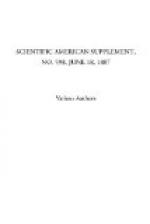The race between guns and armor began about thirty years ago, and there has been more development in ships and guns in that time than in the two hundred preceding years. The jump has been from the 7 in. rifle as the largest piece to the 110 ton Armstrong; in armor, from 41/2 in. of iron to the Inflexible with 22 in. of steel plating. The new Armstrong gun of 110 tons, tried only recently, with 850 pounds of powder and an 1,800 pound shot can pierce all the targets, and so far guns have the victory over armor. This gun developed 57,000 foot tons of energy, and will probably reach 62,000. Imagine the Egyptian needle in Central Park, shod on its apex with hard steel, dropped point downward from the height of Trinity steeple; it weighs 225 tons, and it would strike with just about the effect of one of the 110 ton gun’s projectiles. Two of these guns are ready for the ironclad Benbow, and the Italians have several equally powerful of 119 tons from Herr Krupp. The most powerful gun in the United States, the 15 in. or the 12 in. rifle, has a muzzle energy of 3,800 foot tons.
Ships like the Inflexible are the most powerful afloat. A steel water-tight deck extends across the ship, and she has 135 water-tight compartments. Her guns and engines amidships have a protection of 24 in. of armor, and amidships she has a citadel carrying two revolving turrets, each containing two 80 ton guns. Her turret armor is 18 in. thick. She can make 14 knots, and she has cost $3,500,000. But she has a low freeboard, and the guns, therefore, get no plunging fire.
The French ship Meta has her heaviest guns mounted en barbette, high above the water line, giving a splendid plunging fire.
Either of these ships could enter any of our harbors and hold us at her mercy.
The entrance to the harbor of Alexandria, Egypt, is about 5 miles across. At the time of the bombardment the protecting fortifications were situated at the east end, in the center, and at the west end. On the west there were mounted 20 modern guns of great size and power, and there were 7 others at the east end.
Although the Egyptians fought bravely, they did very little harm to the English fleet, while on the second day the defense was silenced altogether. Following the bombardment—as in Paris—came the reign of mob law, doing more harm than the shells had done; and it is a possibility that every such bombardment would be followed by such an overthrow—at least temporary—of all forms of law and order.
The ships that had silenced the Alexandria batteries—which had 27 heavy guns more than we have—could reach our coasts in 10 or 12 days, and we would have nothing to meet them.
Armor-clad casemates are beginning to take the place of masonry. A tremendous thickness of masonry is built up to the very embrasures for the guns in the steel-clad turrets. This (the Gruson) system has been adopted by Belgium, Holland, Germany, Austria, and Italy.




